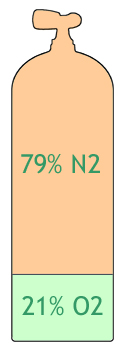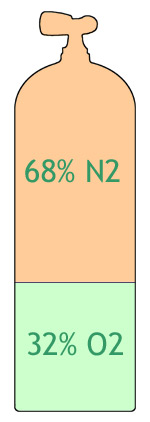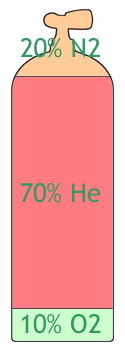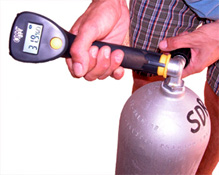
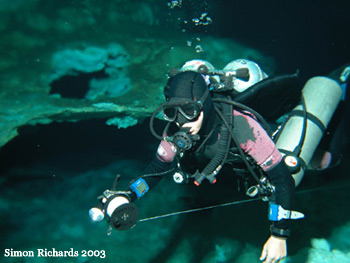
| Cave Formation | |||
| Training & Safety | |||
| Equipment | |||
| Projects | |||
| Papers | |||
| Photos | |||
| Video | |||
| Links | |||
| Contact Us | |||
 |
A drysuit is worn for long dives or in cold water. The suit itself is constructed from a laminated waterproof material, with watertight latex seals at the neck and wrists. Pockets on either side carry safety equipment. Undergarments are worn beneath to provide thermal protection. Bodily functions are managed through the use of a catheter condom connected to a “P-valve”, shown just above the diver’s knee. |
|
|---|---|---|
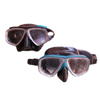 |
Cave divers generally prefer compact masks, normally with an opaque skirt to avoid unwanted reflections. Usually at least one diver in each team will carry a spare mask. |
|
 |
Cave divers generally prefer short stiff fins, to provide good control and compactness. The rubber straps on the fins are often replaced with stainless steel springs covered with plastic tubing – these are stronger and reduce the risk of entanglement in the guideline. |
|
 |
Every diver carries at least one depth gauge and timer. These allow the diver to calculate what decompression stops to make when ascending at the end of the dive, using standard decompression tables. Alternatively, all of these functions may be combined in a dive computer which indicates depth, time and the required decompression stops. Most caves in Quintana Roo are so shallow that only a few minutes of decompression are required, provided an appropriate breathing gas is used (see later). |
|
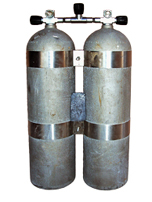 |
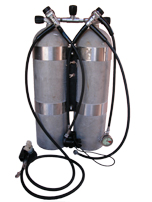 |
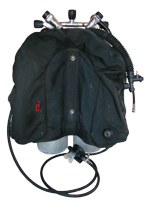 |
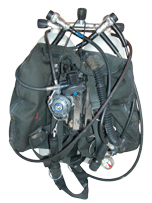 |
|||
|---|---|---|---|---|---|---|
The heart of a cave diver's equipment is the "doubles". These are two tanks held securely together by steel bands, and connected together by a manifold. The manifold has two outlets, each of which can be turned on or off independently in case of problems. The center knob allows the two tanks to be isolated if a problem cannot be solved by turning off one outlet. |
Two fully independent air regulator systems are attached to the outlets of the manifold. Each regulator system has a "first stage", which reduces the pressure from approximately 200 atmospheres to about 10 atmospheres, and a "second stage" (the mouthpiece) which supplies air on demand at ambient pressure. A long hose on one regulator allows divers to share air if necessary while swimming in line through narrow caves. |
A buoyancy compensation device, or "wing", is attached to the tanks. This is essentially an airtight bag which can be inflated to provide buoyancy. Valves allow air to be injected from the tanks or from the diver's mouth to increase buoyancy, or to be released to reduce buoyancy. Valves allow air to be injected from the tanks or from the diver's mouth to increase buoyancy, or to be released to reduce buoyancy. |
The backplate and harness bolt onto the doubles and holds the wing in position. The harness is made from nylon webbing threaded through the backplate and holds the equipment firmly in place on the diver. |
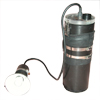 |
Each diver carries a powerful primary light. The canister contains a lead-acid "gel cell" of 6.5 AH (shown left), 9AH or 14 AH capacity and is worn on the harness. The light head is a 10W High Intensity Discharge unit and is connected via a wet connector which can be plugged and unplugged under water. |
|
|---|---|---|
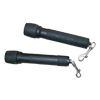 |
Primary lights fail fairly frequently, perhaps every 50 to 100 dives. Each diver, therefore, also carries two backup lights. These are extremely reliable, and provide sufficient light to exit the cave if all primary lights fail. The backup lights are clipped onto D-rings on the diver's harness. |
|
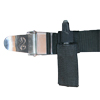 |
Also attached to the harness is a short, sharp knife. This allows the diver to cut himself free in the event of entanglement in the guideline or other equipment. It is common for cave divers to carry more than one knife--we normally attach another knife to the handle of the light head. |
|
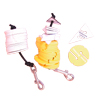 |
Cave divers place directional markers (arrows) and non-directional markers (circles) on the guideline to record information. Directional markers point to the nearest exit from the cave, and non-directional markers are used for a number of purposes, including marking the entrance route. |
|
 |
Each diver always carries a small reel or spool of nylon line known as a "safety reel". This is used when conducting a search for a lost guideline or fellow diver, and to repair any breaks in the guideline. |
|
 |
Waterproof notebooks, or "Wet Notes" are used for a number of purposes. One use is for communication under water, and another is to record reference information during the dive, either to help with navigation inside the cave or for later analysis and planning of subsequent dives. |
|
 |
 |
We can swim with up to three stages, and with Diver Propulsion Vehicles (see next page) we can carry more if the cave is big enough. We always breathe the stage tanks before breathing the double tanks, so that if there is an emergency the empty stage tanks can be abandoned. |
|---|
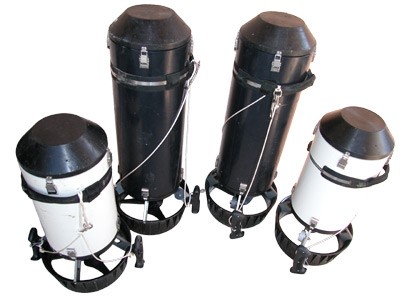 |
Normal swimming speed for a cave diver is 15-20 meters per minute. We use diver propulsion vehicles (DPVs or "scooters") when large distances must be covered, or when lots of equipment must be carried. These are capable of pulling a fully equipped cave diver with several stage tanks at speeds of 50-60 meters per minute. The small scooters have a range of about three kilometers, and the larger scooters have a range of about six kilometers. The scooters are powered by several large lead-acid get cells housed in the tubes. |
|---|---|
| The photo to the right shows an exploration diver with a scooter and one stage tank. This equipment configuration is suitable for cave penetrations of up to about two kilometers. For longer penetrations we take two or three stage tanks and tow a second scooter behind us. This allows penetrations of up to about five kilometers. Whenever we use scooters, we allow sufficient reserve breathing gas to swim out from the furthest point if all scooters fail. | 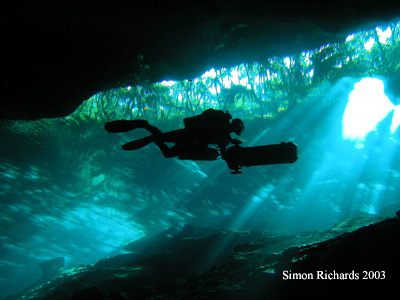 |

